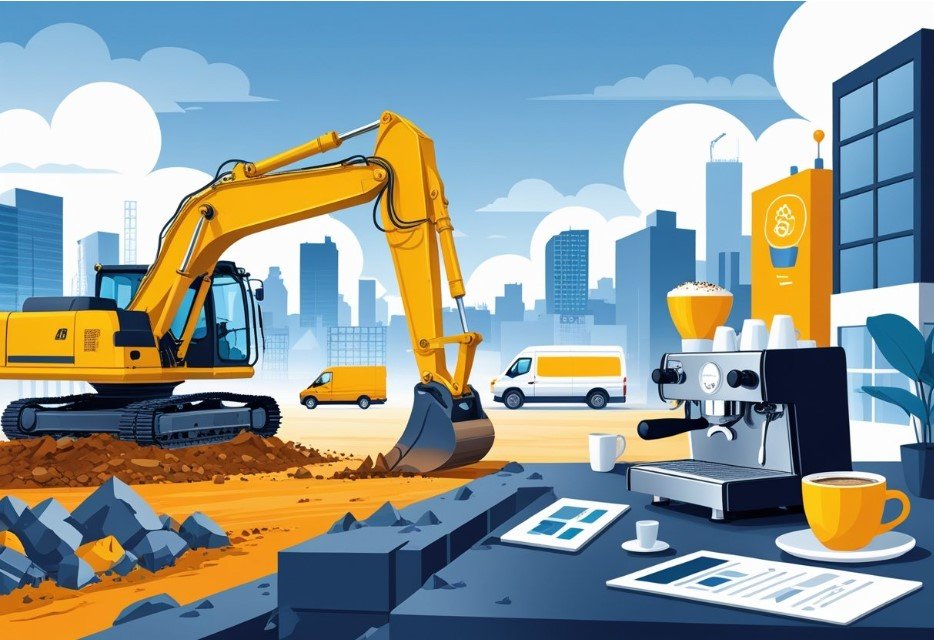Every day, businesses across Australia wrestle with the same issue: they need equipment to grow, but buying it outright can wipe out their cash reserves. Whether it’s a construction crew eyeing a new excavator or a café owner dreaming of a top-tier espresso machine, equipment needs run the gamut. Oddly enough, the financial solution is often the same.
Asset finance lets businesses get vital equipment without coughing up the full price upfront. Instead, they spread the cost over time, hanging on to their working capital. This approach has become a lifeline for businesses of all shapes and sizes—whether they’re after manufacturing tools or medical gadgets, they don’t have to drain their resources just to keep up.
Figuring out how asset finance actually works—and which type fits your business—can totally change the way you think about growth. Whether you’re running heavy machinery or delicate tech, the right financing structure can open doors that might’ve seemed locked.
The Fundamentals of Asset Finance
Asset finance helps businesses snag the equipment they need without a big upfront hit. This financing covers everything from construction gear to coffee machines with agreements that break payments into chunks over time.
What Is Asset Finance?
Asset finance is basically a way for businesses to get equipment, vehicles, and machinery without dropping a huge sum at once. Instead of buying outright, they pay it off over months or years.
It covers physical stuff—manufacturing gear, construction machines, office tech, commercial vehicles, you name it. Even something as small as an espresso machine can fit the bill.
Businesses keep using the gear while making regular payments. Usually, the asset itself acts as security for the loan, which makes lenders more comfortable and can mean better deals for the borrower.
You can finance new or used equipment, and it doesn’t have to be just one thing—sometimes it’s a whole bundle. Financing usually covers most or all of the asset’s value, typically 80% to 100%.
How Asset Finance Works
It starts when a business spots equipment it needs. They send an application to a finance provider, laying out details about the asset and their business. Click here to learn more.
The lender checks things out—credit history, the asset’s value, and how it’ll help the business make money. If the business has strong cash flow and decent credit, they’ll have a better shot at approval.
If things go well, the finance company buys the asset, and the business gets to use it. The business pays monthly over an agreed period. The amount depends on the asset’s price, the loan term, and interest rates.
At the end, the business usually gets a choice: buy the asset, return it, or maybe even upgrade to something newer.
Types of Asset Finance Agreements
Equipment Loans let businesses borrow to buy assets outright. The company owns the gear from day one, but the asset secures the loan until it’s paid off.
Hire Purchase splits ownership and payments. The finance company owns the asset at first, but after a series of payments, ownership shifts to the business.
Operating Leases are more like long-term rentals. Businesses pay monthly to use equipment, and the finance company handles stuff like maintenance. At the end, the business gives the asset back.
Finance Leases hand over most ownership benefits to the business. Payments are usually lower than hire purchase, and at the end, the company can often buy the asset for a small amount.
Benefits of Asset Finance for Businesses
Asset finance keeps cash flow steady by dodging big upfront costs. Companies can hold onto cash for daily needs, emergencies, or unexpected chances to grow.
With asset finance, businesses get access to newer, more efficient gear. Better equipment can boost productivity and lower running costs, which might mean higher profits—even with those monthly payments.
There are usually tax perks, too. Payments can often be claimed as operating expenses, and some agreements let businesses claim depreciation.
Flexibility’s a big plus. When leases end, companies can upgrade their equipment, staying current with tech instead of getting stuck with outdated stuff.
Empowering Businesses: Asset Finance for Diverse Equipment
Asset finance gives businesses across all industries a way to get the gear they need without emptying their bank accounts. Whether it’s construction machinery or a coffee machine, this funding helps companies hold onto working capital while still growing.
Machinery and Heavy Equipment
Construction and manufacturing outfits need pricey machinery to keep going. Asset finance lets them get what they need without draining their reserves.
Common equipment financed includes:
- Excavators and bulldozers
- Cranes and graders
- Manufacturing tools and assembly lines
- Mining equipment
- Agricultural machinery
Spreading out payments means the equipment can start earning money right away. This lets companies take on bigger jobs without waiting years to save up.
Heavy equipment usually holds its value, so lenders are more open to offering good rates. A lot of finance companies get the quirks of these industries and can set up payments that match seasonal ups and downs.
Technology and IT Infrastructure
These days, businesses can’t keep up without solid tech. Asset finance helps them upgrade IT systems without a big cash hit.
Technology purchases often include:
- Computer servers and networking equipment
- Point-of-sale systems
- Software licensing packages
- Medical equipment and diagnostic tools
- Security systems
Tech moves fast, so businesses need to upgrade regularly. Asset finance lets them keep pace without blowing the budget all at once.
Since technology gets outdated quickly, lenders usually offer shorter terms for these assets. That lines up with how businesses actually use and replace their tech.
Hospitality, Retail, and Specialized Equipment
Service businesses need the right gear to keep customers happy. Asset finance helps restaurants, hotels, and shops get what they need to run smoothly.
Popular equipment includes:
- Commercial kitchen equipment like ovens and refrigeration units
- Espresso machines and brewing equipment
- Retail fixtures and display cases
- Cleaning equipment and laundry machines
- Fitness equipment for gyms
Cash flow can get tight in these industries, especially when starting up or expanding. Asset finance lets them invest in quality equipment that draws in customers and keeps things running.
Good equipment matters here—it can make or break the customer experience. Finance options help these businesses buy better gear that lasts and doesn’t break down all the time.
Industry Applications: Real-World Impact of Asset Finance
Asset finance shakes things up across all sorts of sectors by making expensive gear accessible without massive upfront costs. From construction machinery to medical devices, businesses use these solutions to keep cash flow steady while still getting what they need to grow.
Construction and Earthmoving
Construction companies face some of the steepest equipment costs out there. Excavators, bulldozers, and cranes can set you back hundreds of thousands.
Asset finance lets firms spread those costs out. Instead of paying cash up front, they can get heavy machinery through hire purchase or finance leases.
This way, they keep cash on hand for other needs and can chase bigger projects without waiting years to save up.
Key construction equipment financed includes:
- Excavators and backhoes
- Bulldozers and graders
- Cranes and lifting equipment
- Dump trucks and haulers
Modern machines are more reliable and need less maintenance. Asset finance makes it easier to upgrade to newer models instead of squeezing more life out of old ones.
Project demands in construction change all the time. Flexible financing lets companies return or swap equipment as jobs shift.
Manufacturing and Production
Manufacturers rely on specialized machinery that can cost millions. Asset finance helps them get their hands on advanced production gear without burning through cash reserves.
They can upgrade to automated systems that boost efficiency and cut waste. Advanced manufacturing equipment can often pay for itself through higher productivity and lower labor costs.
Spreading costs over a few years helps them manage cash flow. They can keep funds available for materials, wages, or facility upgrades and still get new machinery.
Common financed manufacturing assets:
- CNC machines and lathes
- Assembly line equipment
- Quality control systems
- Packaging machinery
Tech moves fast in manufacturing. Asset finance lets companies stay in the game by upgrading gear before it becomes a bottleneck.
Healthcare and Medical
Medical equipment is a huge expense for healthcare providers. Diagnostic tools and treatment machines can run into the millions.
Asset finance puts this technology within reach for hospitals and clinics. They can offer better care without gutting the budget.
Financing spreads the cost over the equipment’s useful life, matching expenses to the revenue the gear brings in.
Major medical equipment often financed:
- MRI and CT scanners
- X-ray and ultrasound machines
- Surgical equipment and robots
- Patient monitoring systems
Healthcare budgets are tight and have to cover a lot. Asset finance helps facilities get what they need while keeping money on hand for staff, supplies, and maintenance.
Medical tech changes fast, and new gear can really improve patient outcomes. Financing lets providers upgrade as innovations roll out.
Professional Services and Offices
Professional firms need modern equipment to serve clients well. Asset finance makes it possible to get the tech and office gear they need without a massive outlay.
IT equipment and software are big-ticket items for service businesses. Computers, servers, and specialized programs can get expensive fast.
Financing keeps cash free for hiring and marketing. Firms can grow and still get the gear they need.
Common professional service assets financed:
- Computer systems and servers
- Office furniture and fixtures
- Vehicles and delivery equipment
- Specialized software and licenses
Tech gets old quickly in these industries. Asset finance lets firms upgrade regularly and keep pace with client expectations.
Choosing the Right Asset Finance Solution
Making smart choices about asset finance takes some planning (and a bit of shopping around). Business owners need to know their needs, understand the products, and weigh the risks before jumping in.
Assessing Business Needs
Start by figuring out what equipment is truly essential. Make a list of must-haves versus the nice-to-haves.
Next, look at the budget. Know your monthly cash flow and what you can realistically afford to pay back. That way, you won’t end up stretched too thin.
Equipment type affects your options:
- New gear usually gets better rates
- Used stuff might mean shorter loan terms
- Specialized machines could require niche lenders
How quickly the equipment goes out of date matters, too. If it’s going to be obsolete soon, leasing might make more sense.
Think about where the business is headed. If you’re growing, leasing can help you keep cash on hand. If you’re more established, maybe ownership through a loan is the way to go.
Comparing Finance Products
Asset finance comes in three main flavors, each with its own perks and drawbacks.
Equipment loans give you full ownership after you pay them off. Rates are usually fixed, which makes planning easier. Since the gear is collateral, you’ll often get better rates than with unsecured loans.
Equipment leasing has lower upfront costs and usually smaller monthly payments, but you never own the equipment. Leases often include maintenance and upgrade options, which can be handy.
Hire purchase agreements are kind of a mix. You use the equipment while you pay for it, and ownership flips over after the last payment. This works well for stuff that’s going to last a while.
Interest rates can be all over the place. Banks tend to offer better deals to established businesses, while online lenders are faster but might charge more.
Key Considerations and Risks
Asset finance applications really hinge on having solid financial records. Lenders dive into cash flow statements, tax returns, and credit scores. If your paperwork’s a mess, you’ll probably get rejected or stuck with higher rates.
Hidden costs can sneak up on you:
- Application and setup fees
- Early repayment penalties
- Insurance requirements
- Maintenance obligations
Seasonal businesses have their own headaches. When cash flow goes up and down, sticking to regular payments isn’t easy. A few lenders get this and might let you set up flexible payment schedules that fit your income swings.
Equipment that loses value quickly can mess with your loan. Sometimes, you end up owing more than the equipment’s actually worth, which makes refinancing tough.
If you default, what happens depends on your agreement. Lenders might take the equipment back if you stop paying—especially with hire purchase or lease deals.
It’s worth reading every contract term, even the fine print. Getting advice from your accountant or lawyer could save you from headaches down the road.


